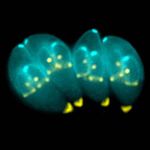Difference between revisions of "Protozoa Flashcards"
Jump to navigation
Jump to search
m |
m (→Coccidia) |
||
| Line 43: | Line 43: | ||
==<font color="purple">Coccidia</font>== | ==<font color="purple">Coccidia</font>== | ||
| + | {| border="3" cellpadding="8" | ||
| + | !width="400"|'''Question''' | ||
| + | !width="400"|'''Answer''' | ||
| + | !width="150"|'''Article''' | ||
| + | |- | ||
| + | |<big>'''What is the transmission and life cycle of ''Eimeria'' species?''' | ||
| + | ||<font color="white"> <big> | ||
| + | *'''''Direct transmission''''' | ||
| + | *'''''Faecal-oral route''''' | ||
| + | ||[[Coccidia#Eimeria|<span title="Answer article">Link to Answer Article</span>]] | ||
| + | |- | ||
| + | |<big>'''What is the transmission and life cycle of ''Isospora'' species?''' | ||
| + | ||<font color="white"> <big> | ||
| + | *'''''Usually direct transmission by the faecal-oral route''''' | ||
| + | *'''''Some species use facultative intermediate hosts forming tissue cysts''''' | ||
| + | **'''''Transmission is then by the faecal-oral or route or via ingestion of the intermediate host''''' | ||
| + | ||[[Coccidia#Isospora|<span title="Answer article">Link to Answer Article</span>]] | ||
| + | |} | ||
| + | |||
==<font color="purple">Cryptosporidia</font>== | ==<font color="purple">Cryptosporidia</font>== | ||
{| border="3" cellpadding="8" | {| border="3" cellpadding="8" | ||
Revision as of 16:58, 7 January 2009
|
|
Protozoa
| Question | Answer | Article |
|---|---|---|
| What are the four different ways protozoa can move? |
|
Link to Answer Article |
| How do protozoa reproduce? |
|
Link to Answer Article |
| Briefly summarise the life cycle of protozoa |
|
Link to Answer Article |
Coccidia
| Question | Answer | Article |
|---|---|---|
| What is the transmission and life cycle of Eimeria species? |
|
Link to Answer Article |
| What is the transmission and life cycle of Isospora species? |
|
Link to Answer Article |
Cryptosporidia
| Question | Answer | Article |
|---|---|---|
| What is the main species of Cryptosporidium which infects humans and domestic animals? |
|
Link to Answer Article |
| True or False: In Cryptosporidium infections unsporulated oocysts are passed in the faeces |
|
Link to Answer Article |
| How are Cryptosporidium infections passed between hosts? |
|
Link to Answer Article |
| How are Cryptosporidium infections prevented? |
|
Link to Answer Article |
Giardia
| Question | Answer | Article |
|---|---|---|
| What is the key points of the life cycle and prepatent period of Giardia? |
|
Link to Answer Article |
| How do both people and animals become infected by Giardia? |
|
Link to Answer Article |
| How would you diagnose a Giardia infection? |
|
Link to Answer Article |
